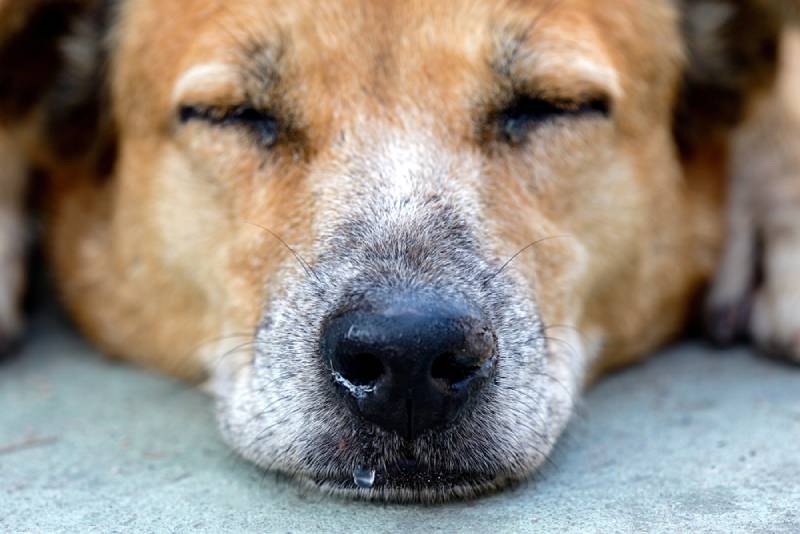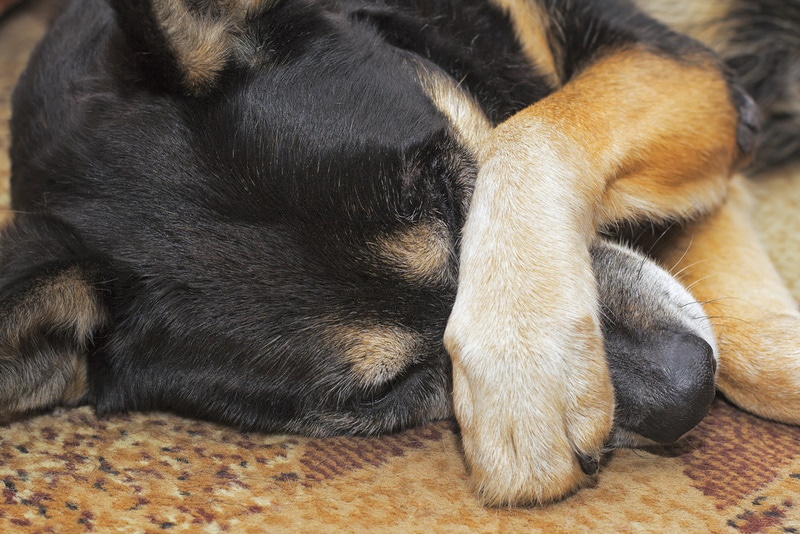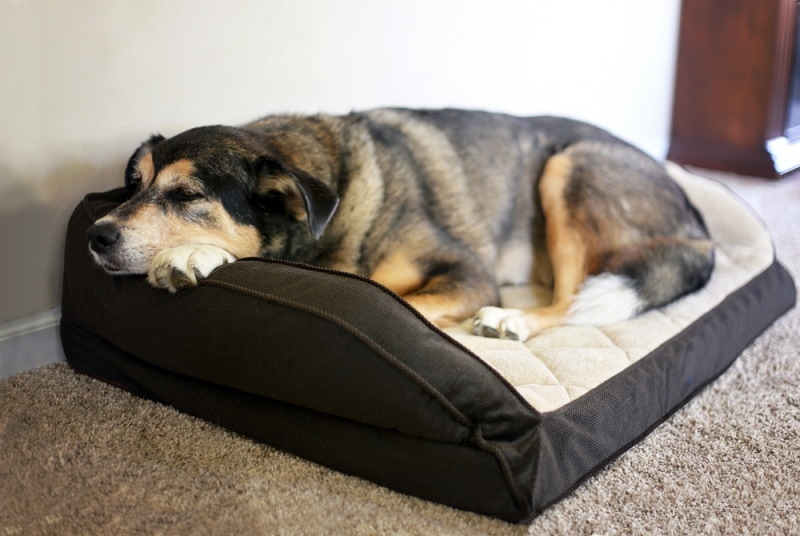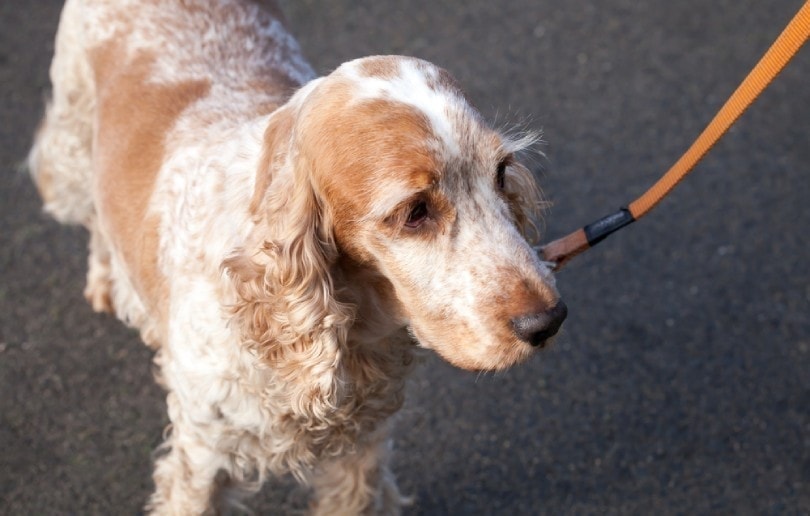Do Dogs Have Nightmares? Vet-Reviewed Canine Sleep Facts & FAQ
By Ed Malaker
Updated on

When it comes to our pets, we often wonder about the complexity of their inner worlds. One intriguing question that frequently arises is whether dogs have nightmares. As owners, we have likely observed our dogs twitching, whimpering, or even barking in their sleep, making us wonder if they are experiencing unpleasant dreams. It is believed that dogs do have nightmares, so keep reading as we explore the scientific evidence and discuss what they may be dreaming about to help you better understand your pet.
Understanding Dreams in Dogs
Like humans, dogs go through several sleep stages, including a state of sleep known as rapid eye movement (REM) sleep, and a period of non-REM sleep. Vivid dreams, including nightmares, occur during REM sleep. Characteristics of this stage include rapid eye movements, increased brain activity, irregular breathing, and muscle paralysis.
Observations and Interpretations

Many dog owners have witnessed their pets displaying peculiar behaviors during sleep, such as leg twitching, paw movements, vocalizations, or even running motions. These actions often occur during the non-REM sleep stage, but it is important to note that these behaviors do not necessarily indicate the presence of nightmares. Dreaming occurs in both phases of sleep.
Scientific Studies
While we cannot directly communicate with our canine friends to ask about their dreams, scientific studies have provided valuable insights into their dream patterns. For example, researchers have used advanced technology, such as electroencephalography, to monitor the brain activity in sleeping dogs. The studies have revealed striking similarities between the brain wave patterns of dreaming dogs and those of humans experiencing REM sleep, suggesting that they have dreams similar to ours. Additionally, a study by MIT explored the relationship between daytime experiences and nighttime dreams in rats. The researchers found that rats exhibited brain activity patterns during sleep that corresponded to the activity observed while performing tests while awake, causing scientists to believe that they were dreaming about the mazes that they had run. Although this study doesn’t focus on dogs, it suggests that animals may process and replay daily events during sleep.
Interpreting Dog Behaviors

While scientific research indicates that dogs do experience dreams, the content of those dreams remains a subject of speculation. Dogs process the world differently from humans, and their dreams likely reflect their unique sensory experiences and perception of the world around them. Therefore, it is crucial to approach their dream interpretations with caution.
Addressing Nightmares in Dogs
Just as humans can have unpleasant dreams or nightmares, it is likely that dogs also experience distressing dream content. Nightmares in dogs could result from various factors, such as previous traumatic experiences, anxiety, or fear-inducing stimuli that might come from spending too much time home alone or an aggressive dog that they met while out walking. We recommend consulting with a veterinarian if you notice persistent signs of distress during your dog’s sleep, such as intense vocalizations, growling, crying, shaking, or frequent waking. Sleep disorders are possible in dogs and it may be that they are not having nightmares but actually are experiencing a sleep disorder. The vet can help determine if there are underlying issues that require attention.
Creating a Peaceful Sleeping Environment

To promote better sleep for your dog, consider providing a comfortable and secure sleeping space. A cozy bed in a quiet area of the house can help create an environment conducive to peaceful sleep. Establishing a consistent bedtime routine and incorporating calming activities like a short walk or gentle play before sleep can also aid in achieving restful slumber.
Should I Wake My Dog?
Most experts recommend that you don’t wake your dog if you notice that they’re having a nightmare because they can lash out at you accidentally, which might result in an injury. Instead, let them sleep it off, and concentrate on providing a comfortable, quiet sleeping area for them.
Other Tips and Tricks
- Pay attention to your dog’s sleep patterns and behaviors. Doing so will help you understand what is normal for your dog and make it easier to distinguish between normal sleep activity and potential problems.
- Create a cozy and secure sleeping area for your dog. Choose a comfortable bed or mat in a quiet corner of the house where your dog can relax and feel safe.
- Establish a regular schedule for feeding, exercise, and bedtime, as dogs enjoy a steady routine.
- Identify and address any factors that might cause distress, such as loud noises, other pets, separation anxiety, or environmental changes.
- Avoid vigorous play, intense exercise, or exposure to bright lights or loud noises close to bedtime. Instead, engage in relaxing activities that promote a sense of calm.
- Avoid projecting human emotions or fears onto their dreams, and focus on providing a safe and nurturing environment.

Final Thoughts
Unfortunately, there is no definite answer to whether dogs have nightmares. While scientific research supports the idea that dogs dream and experience REM sleep, the specific content of their dreams and whether they can have nightmares remains open to interpretation. It is crucial to remember that dogs have different sensory experiences and experience the world differently than humans, which likely influences the nature of their dreams.
So, simply create a safe place for your pet to sleep, and get them into a routine where they can enjoy a bit of relaxing exercise before bed. You don’t need to worry about your dog having nightmares, but if it seems like their sleep activity or patterns have changed, talking to a vet can help you determine if there are any underlying issues to worry about.
Featured Image Credit: Anake Seenadee, Shutterstock













